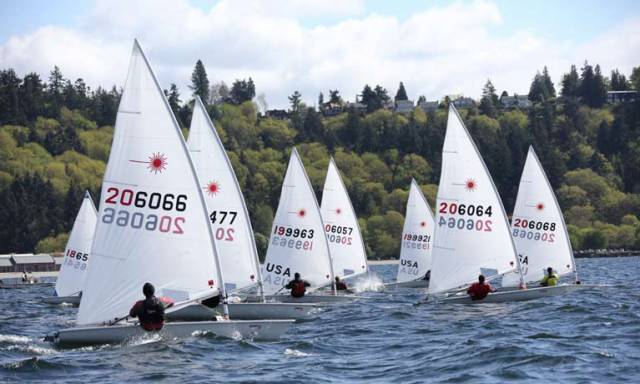At a time when we’re constantly being warned in public life that we have to mark the current “Era of Centenaries” in a sensitive manner, it’s probably insensitive to respond by pointing out that the Irish sailing community is having quite enough trouble, thank you, in getting used to the fact that some boats we still think of as being modern are actually entering the vintage category and beyond writes W M Nixon.
But that’s the way it is. Perhaps “ageless” is not the word we seek. Maybe we should be veering more towards the all-enveloping category of “timeless”. Whatever it is, there are many among us who simply can’t get our heads around the fact that the always-elegant International Dragon is 90 years old in 2019, while the ever-young, fresh-as-a-daisy Laser is having her Golden Jubilee.
Laser Class Golden Jubilee
Or maybe it will be next year – it all depends on how closely things followed on from the ground-breaking Laser-creating phone call in 1969 (or even earlier) between Canadian boat ideas man Ian Bruce, and fellow-Canadian designer Bruce Kirby, aimed at providing an inexpensive easily-carried single-hander which looked good and sailed well.
The boat as she emerged – finally christened the Laser in December 1970 – closely followed Kirby’s original doodle in the immortal style of the best inventions. And of course, she has become one of the few boats to acquire Olympic status (it was in 1996) while remaining genuinely and hugely popular at club level.
We’re well aware that some global Laser production had been going through such a sticky patch recently that we’re now meant to call the officially-recognised boat the “ILCA Dinghy”. But it’s going to take some doing to get a re-naming to stick in place for a boat with the Laser’s long-standing popularity and brand recognition.
This popularity was very clear at last September’s Laser World Masters in Dun Laoghaire, with more than three hundred sailors from all over the globe, and Ireland getting a star performance from Mark Lyttle of the National Yacht Club. A turnout on this scale really was something else – there were Lasers in abundance whichever way you looked, and more than a few of the helms far out-dated the design concept of their wonderful little boats.
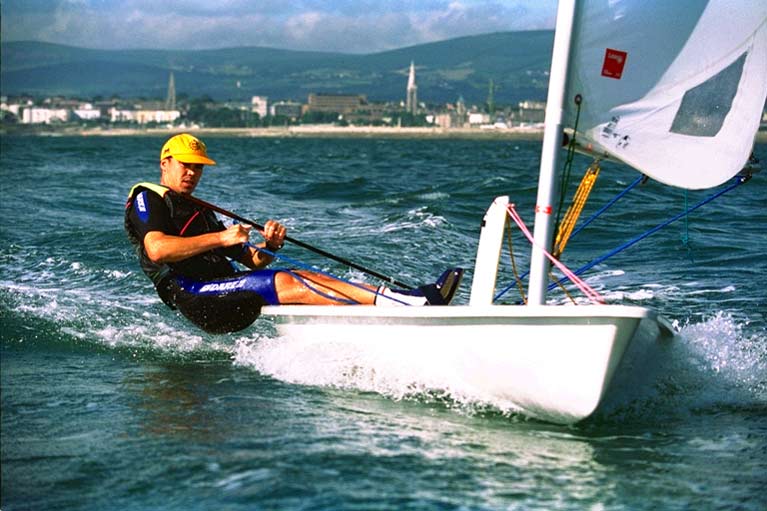 Mark Lyttle (NYC) training in Dublin Bay for the first Olympics with the Laser in 1996, when he was a race winner. Photo: David O’Brien/Afloat.ie
Mark Lyttle (NYC) training in Dublin Bay for the first Olympics with the Laser in 1996, when he was a race winner. Photo: David O’Brien/Afloat.ie Mark Lyttle after winning the Grand Masters Division in the Laser Worlds in Dublin Bay in September 2018. Photo: David O’Brien/Afloat.ie
Mark Lyttle after winning the Grand Masters Division in the Laser Worlds in Dublin Bay in September 2018. Photo: David O’Brien/Afloat.ie
But equally, as the “Masters” categories begin at age 35, there were quite a few helms who had yet to make their debut on the planet when the Laser was already born, so the vintage overall nature of the boat could well match the impressive range of maturity of some of the most senior helms.
This will be in evidence at the Irish Laser Masters this weekend in Howth, where they’ve had a continuous Laser racing programme on the go since 1974. But though Howth’s annual frostbite series for this timeless little boat continue to attract a healthy turnout, as is so often the case the sheer population weighting to be found south of the Liffey means that Dun Laoghaire names pack numbers and success, and defending champion in the Radials is RStGYC’s Sean Craig, who expects strong competition from clubmate Marco Sorgassi, while the home club’s Dan O’Connell, Dave Quinn and Daragh Kelleher are in winning form.
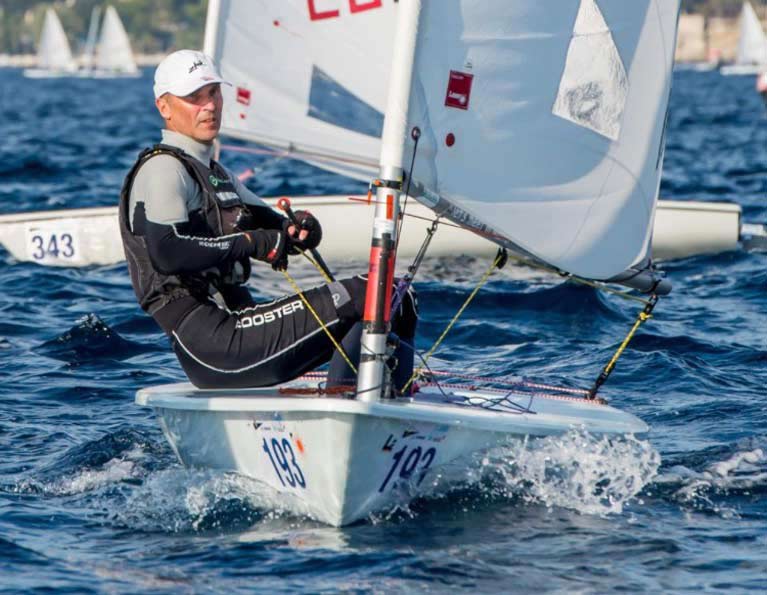 Sean Craig, defending champion in the Radials this weekend’s Irish Laser Masters at Howth
Sean Craig, defending champion in the Radials this weekend’s Irish Laser Masters at Howth
These are all sailors to whom the adjective “timeless” could equally apply - living embodiments of the saying that sailing is a sport for youth of all ages. And even if the Laser does get replaced in the Olympic stakes by some newer design – as has been hinted for the French Olympics in 2024 – we only need to look at the story of the International Dragon to realize that Laser sailors will continue to have their sweet little boats as designed by Bruce Kirby playing a very big part of their life afloat well into the foreseeable future and beyond.
Because once upon a time, the International Dragon was very much a part of the Olympic circus. So much so, in fact, that when she got her marching orders after the 1972 Olympics - having been in the lineup since 1948 – there were those who thought it would lead to an inevitable decline in the class.
Dragon Class is Ninety Years Old
But on the contrary, it seems that most Dragon sailor cared a lot more about the joy they got from their boats than they did about the Olympic thing. So much so, in fact, that today the class is facing into year 90 in the very best of health, and its big championship, the 2019 Yanmar Dragon Gold Cup at Medemblik in the Netherlands from the 8th to 14th June, has already attracted more than a hundred boats from 16 nations in four continents, with Jorgen Schonherr from Denmark the defender after the championship in Finland last year.
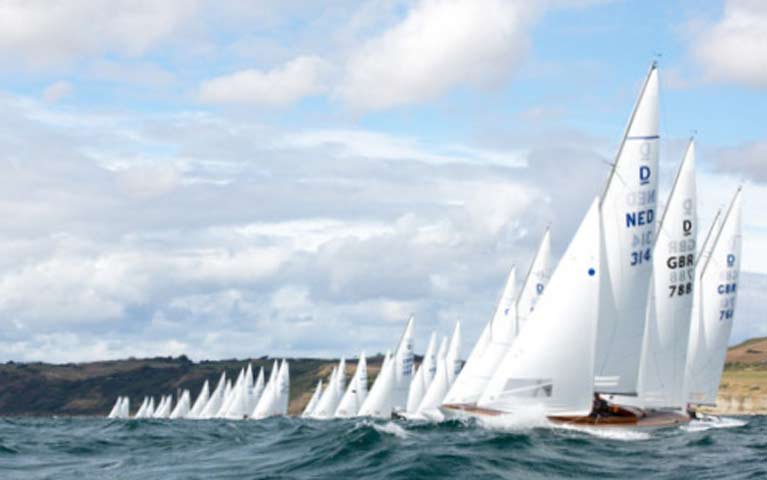 So who needs to be an Olympic class? The Dragon Gold Cup ten years ago. The 2019 event in The Netherlands in June has already attracted more than a hundred entries from sixteen countries.
So who needs to be an Olympic class? The Dragon Gold Cup ten years ago. The 2019 event in The Netherlands in June has already attracted more than a hundred entries from sixteen countries.
The Dragon first appeared in Sweden in 1929 to a design by Norwegian Johan Anker, and there has been Irish involvement in the class since at least 1936. Certainly what is probably the most senior Dragon still racing – Don Street’s Gypsy in Glandore – is all of 86 years old, and she has been in Ireland a long time. As for her extraordinary skipper, he is one of the keenest advocates of the Dragon as a boat for sailors of all ages even if he himself is 89, but he concedes in the Dragon-sailing longevity stakes to Australia’s champion Gordon Ingate, who this year will be 92.
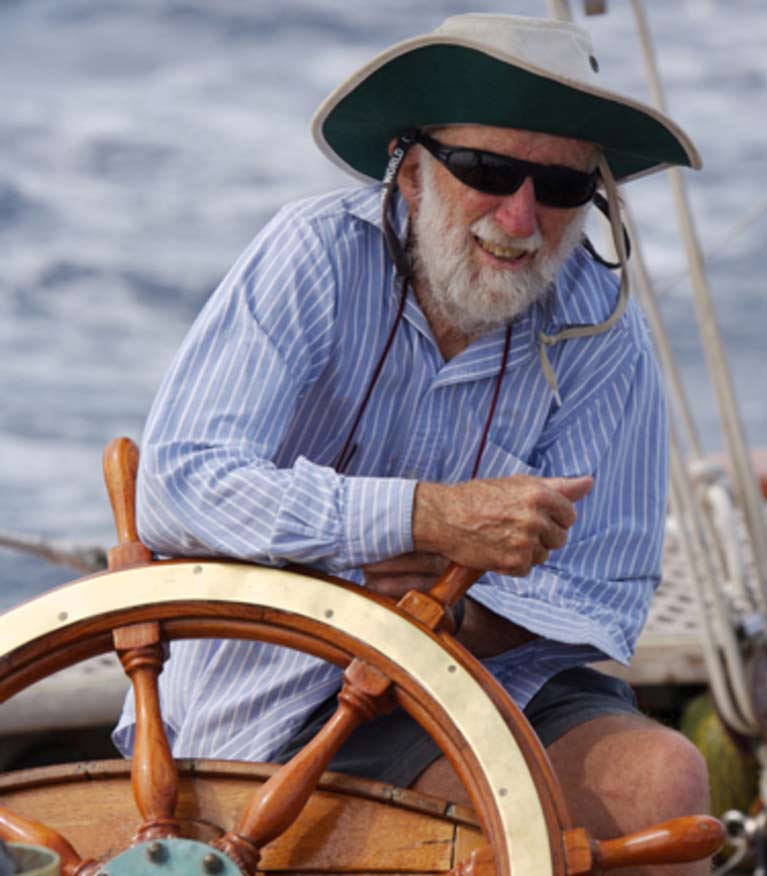 The legendary Don Street – at 89, he races an 86-year-old Dragon with as much enthusiasm as ever
The legendary Don Street – at 89, he races an 86-year-old Dragon with as much enthusiasm as ever
These figures are enough to make anyone dizzy, so to get some idea of the Dragon’s enduring appeal, let’s consider Irish involvement with the Gold Cup, which dates back to 1936. On several occasions, we’ve had a top Irish boat there or thereabouts, but the harsh reality if that it was brought back to Ireland only the once, and it was to Northern Ireland, to the then-thriving Dragon fleet at RNIYC at Cultra on Belfast Lough.
It was 1947, and the winner when the Gold Cup was raced on the Firth of Clyde was Eric Strain of RNIYC helming Billy Barnett’s Ceres. This led in due course to Strain becoming the British Dragon Helm in the 1948 Olympics at Torquay. But as Ceres was just a standard Scandinavian-built Dragon, Billy Barnett – who owned a successful Belfast engineering firm – decided that the exceptional talent of Eric Strain deserved the very best boat that money could buy, so the legendary yacht-building firm of Camper & Nicholson in Gosport were commissioned for the job.
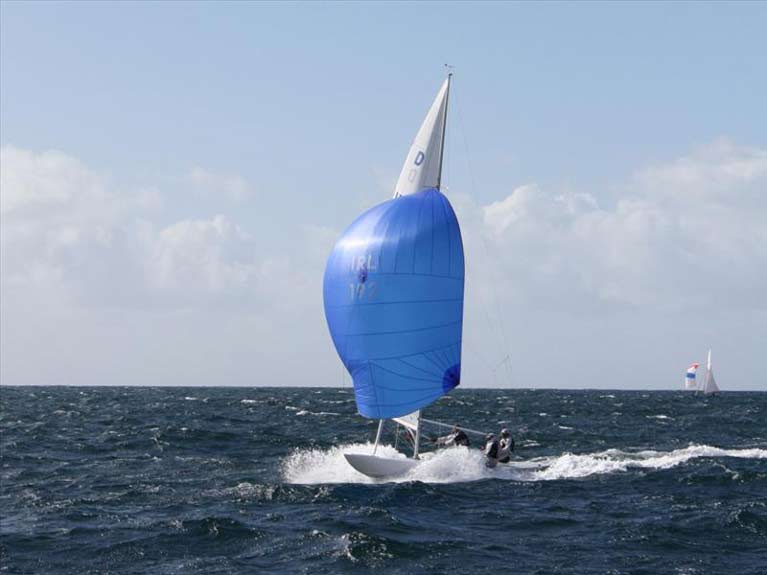 Offshore at Glandore, the Dragons can get up and fly…Photo: GHYC/Richard Harrison
Offshore at Glandore, the Dragons can get up and fly…Photo: GHYC/Richard Harrison
The resulting Ceres II was an exquisite bit of work. Maybe too exquisite. It was suspected that she was slightly heavier and not as fast as the first Ceres, and at the 1948 Olympiad, while Eric Strain and Ceres II did well, it wasn’t quite good enough. They were fourth. In Ireland, we do not need to be reminded of the huge void – a veritable chasm - to be found between the Bronze Medal-winning third and the otherwise commendable but medal-less fourth…….
1948 is now 71 years ago, yet today the International Dragon continues to play a very special role in world sailing. It’s something we take for granted. But what other sport would be continuing to use equipment designs whose unchanged basic concept originated 90 years ago? Boats which - to many of us - still seem well up-to-date.
Historic Ketch Ilen
It brings us back to that concept of timelessness. This weekend, the Limerick ketch Ilen will be on passage from Dunmore East towards Dublin Bay, and when people get to see her at Poolbeg from Sunday evening, and at the Royal Irish YC in Dun Laoghaire next Friday, they’ll be in no doubt that they’re looking at a concept of considerable antiquity, as her design of 1926 was evolved from Conor O’Brien’s Saoirse design of 1923, which O’Brien said was in turn inspired to some extent by a notably able Arklow fishing boat which dated from the 1860s.
Whatever the origins, it means that Ilen is only three years older than the International Dragon, and that the Laser has been around for more than half of Ilen’s existence. Truly, ours is one extraordinary sport. And if you really want to point up the oddities of vehicle design which sailing can produce, just consider that some years ago the berth at the RIYC which Ilen will occupy was very elegantly filled by the 70ft Fife designed-and-built cutter Hallowe’en.
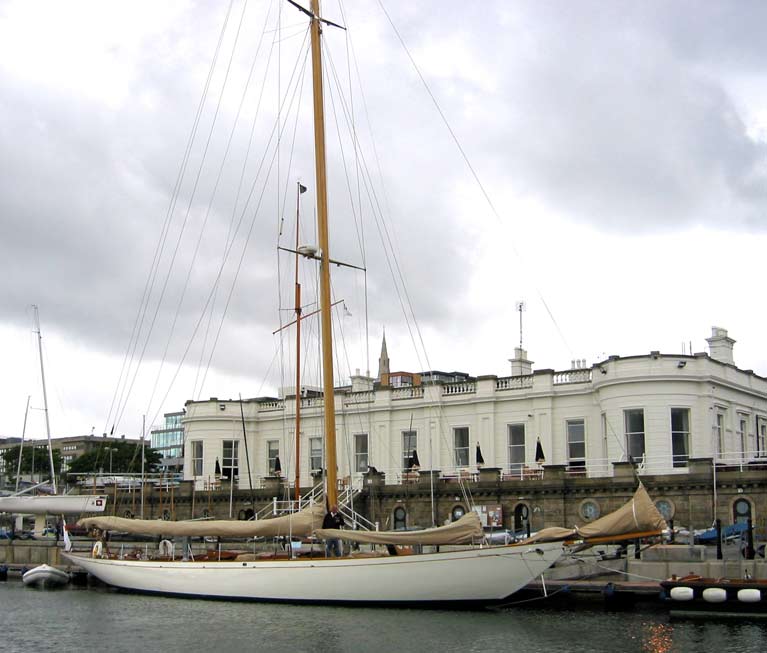 A Fastnet Race record setter, the 70ft Fife cutter Hallowe’en (seen here at the RIYC in Dun Laoghaire) was built in 1926. Photo: W M Nixon
A Fastnet Race record setter, the 70ft Fife cutter Hallowe’en (seen here at the RIYC in Dun Laoghaire) was built in 1926. Photo: W M Nixon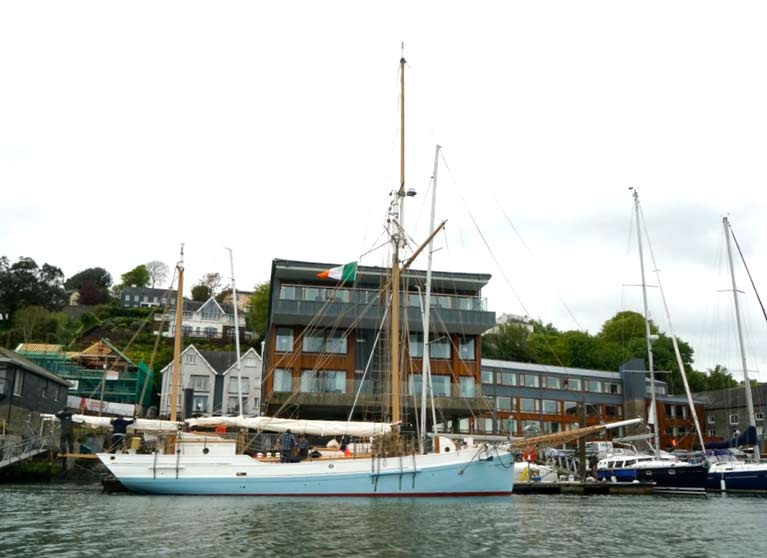 The 56ft Ilen – seen here in Kinsale this week – was also built in 1926. Photo: Gary MacMahon
The 56ft Ilen – seen here in Kinsale this week – was also built in 1926. Photo: Gary MacMahon
Hallowe’en was built in 1926, and she took line honours in that year’s Fastnet Race in a record time which stood for many years. It’s mind-boggling to think that in the same year – and in a boatyard at Baltimore near the Fastnet Rock itself – the unbelievably different Ilen took shape. Yet such is the case, and next Friday we’ll have the opportunity to savour the variety of sailing craft which the special calls of seafaring can produce - and each and every one of them has their devoted adherents.



























